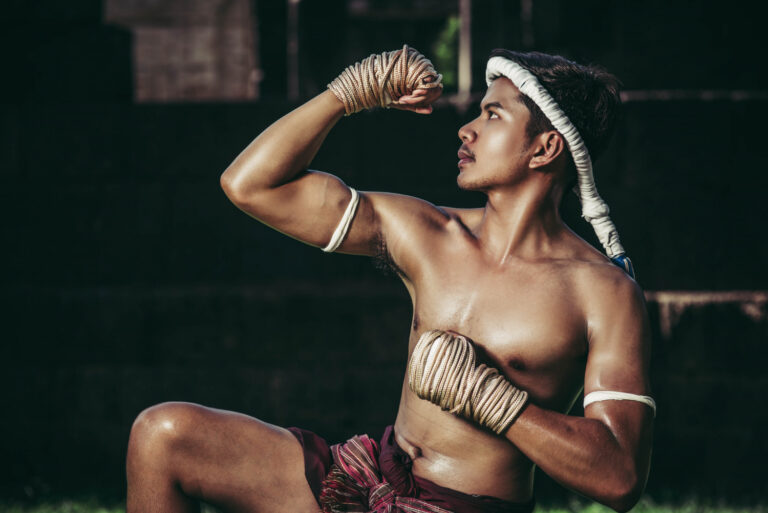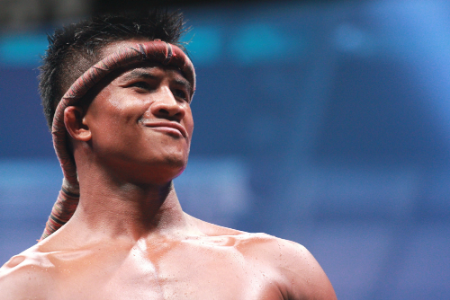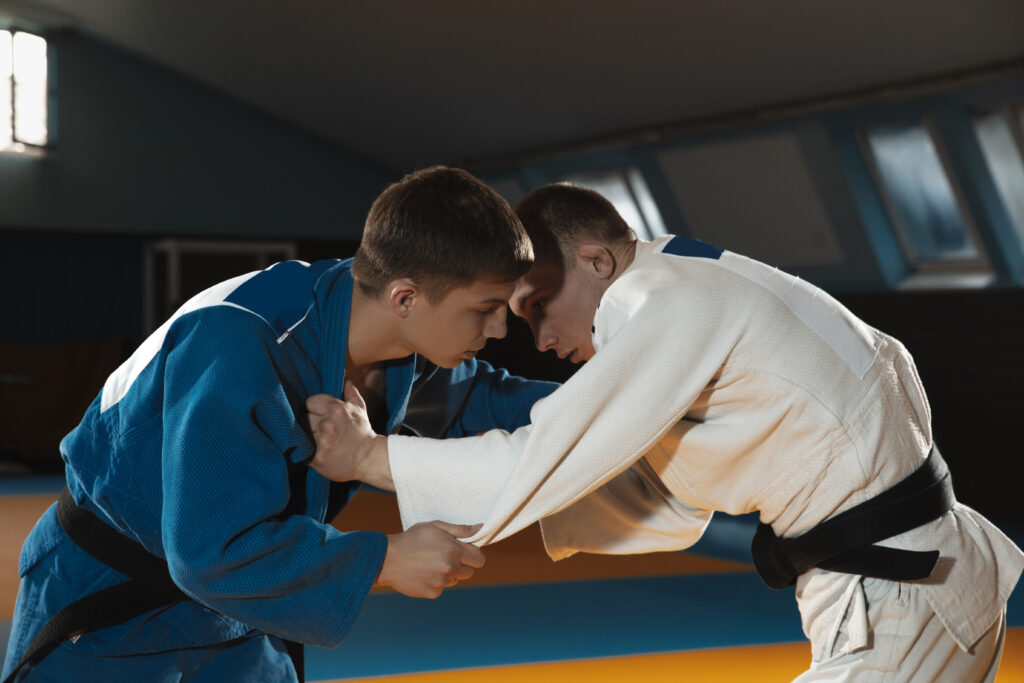
When embarking on your combat sports journey, choosing a style that resonates with you is the first major step. This guide will give you an introductory understanding of five major combat sports styles: Boxing, Muay Thai, Karate, Judo, and Brazilian Jiu-Jitsu (BJJ).
Boxing, known as the ‘Sweet Science,’ is a discipline focused solely on punching. Boxing matches are a test of strategy, speed, strength, and stamina. Boxing is an excellent choice for those looking to improve their hand-eye coordination and cardiovascular health.
Muay Thai, also known as the ‘Art of Eight Limbs,’ incorporates fists, elbows, knees, and shins into its striking. Originating from Thailand, Muay Thai is renowned for its devastating kicks and clinch work.
Karate is a traditional martial art originating from Okinawa, Japan. It is a striking art using punching, kicking, knee strikes, and open-hand techniques. Karate is highly respected for its disciplined approach to self-improvement.
Judo, also from Japan, is primarily a grappling martial art. Its techniques involve throws and submissions, with an emphasis on using the opponent’s energy against them. Judo is an Olympic sport and a great way to build physical and mental resilience.
Brazilian Jiu-Jitsu (BJJ) is a martial art that focuses on ground fighting and submissions, with the objective being to control and submit your opponent using various techniques. BJJ promotes the concept that a smaller, weaker person can successfully defend against a bigger, stronger assailant.
Each of these styles offers unique benefits and challenges, and your choice will depend on your personal preferences and goals. For a more in-depth look into each style, feel free to explore our individual guides.
Boxing: The Sweet Science
Boxing is one of the oldest and most efficient combat sports. Known as the ‘Sweet Science’, it combines raw power with strategy, speed, and skill. If you’re interested in a combat sport that tests your mental and physical toughness, boxing could be your perfect match.
History and Origins
Boxing has a rich history that spans millennia, from the ancient civilizations of Greece and Rome to modern arenas worldwide. However, it was in 18th century England that boxing began to develop into the sport we recognize today.
Understanding Boxing
At its core, boxing is a sport of intricate simplicity. Two combatants face off in a ring, aiming to score points by landing clean punches on their opponent. The beauty lies in the details: footwork, timing, speed, defense, and power. There are four primary punches in boxing – the jab, cross, hook, and uppercut.
Training and Conditioning
Boxing requires excellent physical conditioning. A typical training session may include cardio exercises, strength training, shadow boxing, bag work, sparring, and more.
Competition and Rules
Boxing matches are divided into rounds, with professional fights usually being 12 rounds of three minutes each. Points are scored for each clean punch landed on the opponent’s torso or head. The match can end via knockout, technical knockout, or go to the judges’ scorecards.
Getting Started with Boxing
If you’re considering boxing, start by finding a reputable gym with experienced trainers. Boxing can be intense, but remember – everyone starts somewhere. Don’t be discouraged if progress seems slow; boxing is as much about mental fortitude as it is about physical strength.
Muay Thai: The Art of Eight Limbs

Muay Thai, also known as “The Art of Eight Limbs”, is a combat sport from Thailand that utilizes punches, kicks, elbows, and knee strikes. It’s a full-contact sport that demands physical preparation and mental strength.
History and Origins
Muay Thai has roots dating back several centuries in Thailand. It was originally developed as a form of close-combat that used the entire body as a weapon. Today, it’s recognized worldwide for its raw efficiency and is a key component in Mixed Martial Arts (MMA) training.
Understanding Muay Thai
Muay Thai is unique because it involves the use of the fists, elbows, knees, and shins – the so-called “eight limbs”. The techniques involve striking and clinching. In addition to physical prowess, the sport also requires strategic thinking as the competitors try to exploit their opponents’ weaknesses.
Training and Conditioning
Muay Thai training is physically demanding and involves workouts that boost strength, endurance, and flexibility. A typical training session could include running, shadow boxing, bag work, pad work, strength training, and flexibility exercises.
Competition and Rules
Muay Thai matches are typically five rounds long, with each round lasting three minutes. The winner is determined by knockout or judge’s decision based on the effectiveness of strikes, aggression, and control of the ring.
Getting Started with Muay Thai
Starting Muay Thai involves finding a reputable gym with qualified instructors. The sport is intense and physically demanding, but with consistent training, anyone can learn and appreciate the art of Muay Thai.

Karate: The Way of the Empty Hand

Karate, translating to “The Way of the Empty Hand”, is a martial art that originated in Okinawa, Japan. It focuses on striking techniques such as punches, knee strikes, kicks, and elbow strikes.
History and Origins
Karate was developed in the Ryukyu Kingdom, which is now known as Okinawa, Japan. The art form was influenced by Chinese martial arts and developed into a unique Okinawan style that was systematically taught in Japan and later across the globe.
Understanding Karate
Karate emphasizes the use of the hands and feet for strikes and blocks, training the practitioner to use their body as a weapon. Training usually involves three components: kihon (basics), kata (forms), and kumite (sparring).
Training and Conditioning
Training in Karate involves learning and practicing techniques (kihon), forms (kata), and sparring (kumite). It also incorporates physical conditioning exercises to enhance strength, speed, flexibility, and endurance.
Competition and Rules
In Karate competitions, participants can compete in kata (forms) or kumite (sparring). Points are awarded for successful strikes, and the competitor with the most points at the end of the match is the winner.
Getting Started with Karate
Starting Karate involves finding a reputable dojo with experienced instructors. Karate is suitable for all ages and fitness levels, making it a popular choice for those looking to get into martial arts.


Judo: The Gentle Way

Judo is a popular martial art that focuses on throws and grappling. It translates to “The Gentle Way” and emphasizes the use of an opponent’s force against themselves.
History and Origins
Judo was developed in Japan by Jigoro Kano in the late 19th century. Kano was a student of jujitsu, the traditional Japanese combat art. However, he developed a philosophy of mutual welfare and benefit and a system of physical, mental, and moral education, which he named Judo.
Understanding Judo
Judo involves using balance, leverage, and movement to overthrow your opponent. It also includes techniques for pinning an opponent, joint locks, and chokeholds. The two main categories of techniques in judo are Nage-waza (throwing techniques) and Katame-waza (grappling techniques).
Training and Conditioning
Judo training involves learning and practicing throws and grappling techniques. Physical conditioning is also an important part of Judo training, including exercises to improve strength, endurance, and flexibility.
Competition and Rules
In Judo competitions, participants are awarded points for successful throws, pins, and submissions. Matches are won either by scoring more points than your opponent or by ippon, a perfect score achieved by executing a clean throw, holding a pin for 20 seconds, or forcing a submission.
Getting Started with Judo
To get started in Judo, find a reputable dojo with experienced instructors. Judo is suitable for all ages and fitness levels, and it is known for its community spirit and emphasis on respect.


Brazilian Jiu-Jitsu: The Game of Human Chess

Brazilian Jiu-Jitsu (BJJ) is a martial art form that focuses on ground fighting and submission holds. BJJ is often referred to as the game of human chess due to its complexity and the level of strategy involved.
History and Origins
Brazilian Jiu-Jitsu evolved from Kodokan Judo in the early 20th century. Mitsuyo Maeda, a Japanese judoka, emigrated to Brazil and taught Carlos Gracie, who then passed the knowledge to his brothers. The Gracie family developed and refined the art into what we know today as Brazilian Jiu-Jitsu.
Understanding Brazilian Jiu-Jitsu
BJJ prioritizes technique over strength, which allows smaller and weaker practitioners to defend against and even overcome larger and stronger opponents. The art involves takedowns, ground control, and, most importantly, submission holds that force the opponent to give up.
Training and Conditioning
Training in BJJ involves learning and drilling techniques, sparring (also known as rolling), and physical conditioning. The training is physically demanding and improves flexibility, strength, cardiovascular fitness, and mental toughness.
Competition and Rules
In BJJ competitions, athletes can win by points, advantages, or by forcing their opponent to submit using submission holds. Points are given for achieving dominant positions or performing specific maneuvers.
Getting Started with Brazilian Jiu-Jitsu
Finding a reputable BJJ academy and starting with beginner’s classes is the best way to begin your Brazilian Jiu-Jitsu journey. The art is known for its welcoming and inclusive community, making it a suitable choice for individuals of all ages and physical conditions.


Exploring the World of Combat Sports: A Journey Just Beginning
And there you have it – a comprehensive introduction to five of the most popular and influential combat sports styles in the world: Boxing, Muay Thai, Karate, Judo, and Brazilian Jiu-Jitsu. Each of these martial arts forms offers a unique approach to self-defense, fitness, and mental discipline. They each carry a rich history and tradition, and they have evolved over time to become the sports we know and love today.
But remember, this is just the beginning of your journey. The world of martial arts is vast and diverse, and each style represents just a small piece of the larger puzzle. Whether you’re looking to take up a new hobby, improve your fitness, or dive deep into the strategic complexities of human combat, there’s a martial art form out there waiting for you to discover.
So, we encourage you to lace up those gloves, tie that belt, and step onto the mat. Explore the techniques, delve into the philosophies, and immerse yourself in the culture of each style. Discover the art that resonates with you the most and start your martial arts journey today.
Thank you for joining us in this exploration of combat sports styles. We look forward to being a part of your ongoing martial arts journey.






